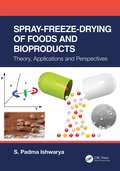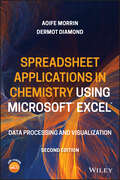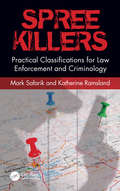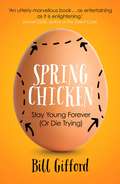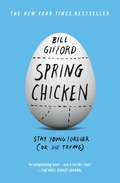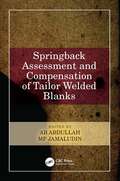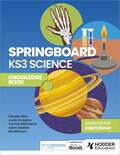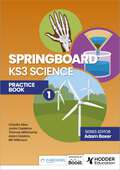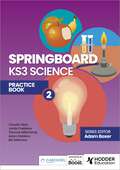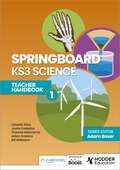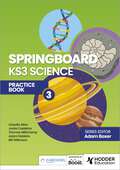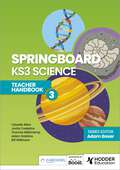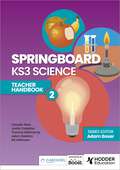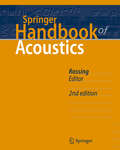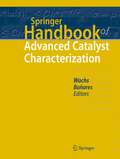- Table View
- List View
Spray-Freeze-Drying of Foods and Bioproducts: Theory, Applications and Perspectives
by S. Padma IshwaryaSpray-freeze-drying (SFD) is a synergistic drying technology that imbibes in it the merits of both spray drying and freeze-drying, whilst overcoming the limitations of these predecessor technologies. SFD produces uniquely powdered food and pharmaceutical products with porous microstructure and superior quality attributes. Owing to its atomization step and ultra-low-temperature operation, SFD is a competent drying technique for the production of valuable but sensitive bioactive components. Despite the costs and complexities involved, SFD has a competitive edge over the conventional drying techniques in providing distinctive product attributes. The applications of spray-freeze-drying in the area of food and bioproducts span across the product categories of instant food powders, dry flavors, active pharmaceutical ingredients, poorly water-soluble drugs, probiotics, proteins, enzymes and vaccines. Spray-Freeze-Drying of Foods and Bioproducts: Theory, Applications and Perspectives is the first exclusive title on this interesting drying technique. It provides a comprehensive understanding of the fundamentals of SFD and its food and pharmaceutical applications. The scope of this book, comprising 12 chapters, has been organizedunder four major headings: fundamentals of process-stages, applications with case-studies, recent advancements and the processing bottlenecks and solutions. Key Features Provides examples and case studies of nuances and intricacies associated with each stage of the spray-freeze-drying process Highlights the applications of spray-freeze-drying in the production of food products including soluble coffee, dairy powders, probiotics and flavors Serves as a ready-reckoner of characterization methods for spray-freeze-dried products Contains 200+ illustrations and tabulations The contents of this book are organized to cater to the knowledge needs of students, academicians, researchers and professionals in the food and pharmaceutical industry.
Spreadsheet Applications in Chemistry Using Microsoft Excel: Data Processing and Visualization
by Aoife Morrin Dermot DiamondSPREADSHEET APPLICATIONS IN CHEMISTRY USING MICROSOFT® EXCEL® Find step-by-step tutorials on scientific data processing in the latest versions of Microsoft® Excel® The Second Edition of Spreadsheet Applications in Chemistry Using Microsoft® Excel® delivers a comprehensive and up-to-date exploration of the application of scientific data processing in Microsoft® Excel®. Written to incorporate the latest updates and changes found in Excel® 2021, as well as later versions, this practical textbook is tutorial-focused and offers simple, step-by-step instructions for scientific data processing tasks commonly used by undergraduate students. Readers will also benefit from an online repository of experimental datasets that can be used to work through the tutorials to gain familiarity with data processing and visualization in Excel®. This latest edition incorporates new and revised content to use to learn the basics of Excel® for scientific data processing and now includes statistical analysis and regression analysis using Excel® add-ins, accounts for differences in navigation and utility between Windows and MacOS versions of the software, and integrates with an online dataset repository for the tutorial exercises. Spreadsheet Applications in Chemistry Using Microsoft® Excel® also includes: A thorough introduction to Microsoft® Excel® workbook and worksheet basics, including Excel® toolbar navigation, entering and manipulating formulas and functions and charting experimental chemical data Comprehensive explorations of statistical functions and regression analysis Generating calibration plots from instrumental data Visualizing concepts in physical chemistry Perfect for undergraduate and graduate students of analytical and physical chemistry, Spreadsheet Applications in Chemistry Using Microsoft® Excel® is also an ideal resource for students and practitioners of physics, engineering, and biology.
Spree Killers: Practical Classifications for Law Enforcement and Criminology
by Katherine Ramsland Mark SafarikSpree Killers: Practical Classifications for Law Enforcement and Criminology is the only exhaustive, up-to-date analytical book on spree killers, standing apart from those dedicated to mass murderers and serial killers. Multicides have traditionally been categorized as double, triple, mass, serial and spree— while, mass and serial have been further divided into subcategories. Spree killing, which involves the killing of at least three persons at two or more locations due to a precipitating incident that fuels the urge to kill, remains a poorly defined concept. In the United States, the Federal Bureau of Investigation (FBI) eliminated this term from its multicide nomenclature in 2005, but the authors examination of 359 cases involving 419 spree killers from 43 countries shows that not only is there enough diversity among spree killers to form classifications—similar to those devised for mass and serial—but also that subtypes offer distinct utility for identification, tracking, and warning potential targets. Spree Killers outline the designation of spree killer specifically and thoroughly. In addition to looking at existing literature, specific cases, and the behavioral patterns, it offers a fully worked up profile for the typology. The behaviors and motives for spree killers align in six categories, which are detailed in full. The book provides unique insight for police, forensic, and investigative personnel into what to look for to respond to, and—in some cases identify and stopping—certain types of spree killings.
Spring After Spring: How Rachel Carson Inspired the Environmental Movement
by Stephanie Roth SissonFrom Stephanie Roth Sisson, the creator of Star Stuff, comes a picture book biography of Rachel Carson, the iconic environmentalist who fought to keep the sounds of nature from going silent.As a child, Rachel Carson lived by the rhythms of the natural world. Spring after spring, year after year, she observed how all living things are connected. And as an adult, Rachel watched and listened as the natural world she loved so much began to fall silent. Spring After Spring traces Rachel’s journey as scientist and writer, courageously speaking truth to an often hostile world through her book, and ultimately paving the way for the modern environmental movement.
Spring Chicken: Stay Young Forever (or Die Trying)
by Bill GiffordThe dangerous pitfalls and extraordinary possibilities we face in our quest for eternal youth.
Spring Chicken: Stay Young Forever (or Die Trying)
by Bill GiffordFrom acclaimed journalist Bill Gifford comes a roaring journey into the world of anti-aging science in search of answers to a universal obsession: what can be done about getting old?SPRING CHICKEN:Stay Young Forever (or Die Trying)SPRING CHICKEN is a full-throttle, high-energy ride through the latest research, popular mythology, and ancient wisdom on mankind's oldest obsession: How can we live longer? And better? In his funny, self-deprecating voice, veteran reporter Bill Gifford takes readers on a fascinating journey through the science of aging, from the obvious signs like wrinkles and baldness right down into the innermost workings of cells. We visit cutting-edge labs where scientists are working to "hack" the aging process, like purging "senescent" cells from mice to reverse the effects of aging. He'll reveal why some people live past 100 without even trying, what has happened with resveratrol, the "red wine pill" that made headlines a few years ago, how your fat tissue is trying to kill you, and how it's possible to unlock longevity-promoting pathways that are programmed into our very genes. Gifford separates the wheat from the chaff as he exposes hoaxes and scams foisted upon an aging society, and arms readers with the best possible advice on what to do, what not to do, and what life-changing treatments may be right around the corner. An intoxicating mixture of deep reporting, fascinating science, and prescriptive takeaway, SPRING CHICKEN will reveal the extraordinary breakthroughs that may yet bring us eternal youth, while exposing dangerous deceptions that prey on the innocent and ignorant.
Spring Wildflowers of the San Francisco Bay Region (California Natural History Guides #11)
by Helen K. SharsmithThis title is part of UC Press's Voices Revived program, which commemorates University of California Press’s mission to seek out and cultivate the brightest minds and give them voice, reach, and impact. Drawing on a backlist dating to 1893, Voices Revived makes high-quality, peer-reviewed scholarship accessible once again using print-on-demand technology. This title was originally published in 1965.
Springback Assessment and Compensation of Tailor Welded Blanks
by Ab Abdullah Mf JamaludinFocusing on techniques developed to evaluate the forming behaviour of tailor welded blanks (TWBs) in sheet metal manufacturing, this edited collection details compensation methods suited to mitigating the effects of springback. Making use of case studies and in-depth accounts of industry experience, this book gives a comprehensive overview of springback and provides essential solutions necessary to modern-day automotive engineers. Sheet metal forming is a major process within the automotive industry, with advancement of the technology including utilization of non-uniform sheet metal in order to produce light or strengthened body structures. This is critical in the reduction of vehicle weight in order to match increased consumer demand for better driving performance and improved fuel efficiency. Additionally, increasingly stringent international regulations regarding exhaust emissions require manufacturers to seek to lighten vehicles as much as possible. To aid engineers in optimizing lightweight designs, this comprehensive book covers topics by a variety of industry experts, including compensation by annealing, low-power welding, punch profile radius and tool-integrated springback measuring systems. It ends by looking at the future trends within the industry and the potential for further innovation within the field. This work will benefit car manufacturers and stamping plants that face springback issues within their production, particularly in the implementation of TWB production into existing facilities. It will also be of interest to students and researchers in automotive and aerospace engineering.
Springboard: KS3 Science Knowledge Book
by Adam Robbins Jovita Castelino Claudia Allan Thomas Millichamp Bill WilkinsonCover all the knowledge that students need to know for Key Stage 3 Science in one book.Powered by cognitive science principles, this knowledge-rich book enables students to keep revisiting content, see the links between the sciences, and develop deeper understanding.Our expert author team have used their extensive experience of research-informed teaching practice to create this carefully thought-out Knowledge Book. It will establish and embed the key scientific knowledge and skills that students need to succeed at KS3, ensuring they feel enthused and confident about progressing to GCSE. > Take a new approach to KS3 Science. This Knowledge Book sequences the National Curriculum with unprecedented precision, enabling students to progress through KS3 with ease and fluency.> Reduce cognitive load. Every topic is explained through a succinct and focused table of questions and answers, which captures all the essential knowledge that pupils need.> Use visual aids to further understanding. Complex topics are paired with annotated diagrams, and worked examples are provided to illustrate key skills and calculations in further detail.> Strengthen scientific skills throughout. 'Working Scientifically' pages integrate principles and concepts into students' understanding, using questions and answers, diagrams, tables and more.
Springboard: KS3 Science Knowledge Book
by Adam Robbins Jovita Castelino Claudia Allan Thomas Millichamp Bill WilkinsonCover all the knowledge that students need to know for Key Stage 3 Science in one book.Powered by cognitive science principles, this knowledge-rich book enables students to keep revisiting content, see the links between the sciences, and develop deeper understanding.Our expert author team have used their extensive experience of research-informed teaching practice to create this carefully thought-out Knowledge Book. It will establish and embed the key scientific knowledge and skills that students need to succeed at KS3, ensuring they feel enthused and confident about progressing to GCSE. > Take a new approach to KS3 Science. This Knowledge Book sequences the National Curriculum with unprecedented precision, enabling students to progress through KS3 with ease and fluency.> Reduce cognitive load. Every topic is explained through a succinct and focused table of questions and answers, which captures all the essential knowledge that pupils need.> Use visual aids to further understanding. Complex topics are paired with annotated diagrams, and worked examples are provided to illustrate key skills and calculations in further detail.> Strengthen scientific skills throughout. 'Working Scientifically' pages integrate principles and concepts into students' understanding, using questions and answers, diagrams, tables and more.
Springboard: KS3 Science Practice Book 1
by Adam Boxer Adam Robbins Jovita Castelino Claudia Allan Thomas Millichamp Bill WilkinsonProvide all the independent practice needed for your Springboard Science course with over 1000 questions in each Practice Book.Designed to be used alongside our Knowledge Book, our Practice Books provide shed loads of practice (SLOP) for students to consolidate, apply and extend the knowledge that they have learnt.With decades of teaching experience and extensive knowledge of applying cognitive science in the classroom, you can trust our author team to have created carefully crafted and varied questions for independent practice.> Improve students' long-term retention. Spacing is built in throughout this Practice Book, improving retention over time.> Highlight connections between topics and Sciences. Interleaving of content encourages students to recognise and focus on the connections, similarities and differences across science, enabling them to reflect on their learning in more depth.> Build confidence in the key skills. Question sets include coverage of the key mathematical and working scientifically skills that students need to understand, ensuring that this knowledge is embedded throughout their independent practice.> Support every student. Links to the relevant worked examples in the Knowledge Book are highlighted throughout each unit for easy reference.> Prepare for the next step. Questions increase in difficulty throughout each topic, enabling students to progress through the KS3 curriculum and prepare for KS4 and beyond. Answers are available online for free, and also embedded into the lesson presentations in our Boost digital teaching and learning resources for easy in-class independent practice review.
Springboard: KS3 Science Practice Book 1
by Adam Boxer Adam Robbins Jovita Castelino Claudia Allan Thomas Millichamp Bill WilkinsonProvide all the independent practice needed for your Springboard Science course with over 1000 questions in each Practice Book.Designed to be used alongside our Knowledge Book, our Practice Books provide shed loads of practice (SLOP) for students to consolidate, apply and extend the knowledge that they have learnt.With decades of teaching experience and extensive knowledge of applying cognitive science in the classroom, you can trust our author team to have created carefully crafted and varied questions for independent practice.> Improve students' long-term retention. Spacing is built in throughout this Practice Book, improving retention over time.> Highlight connections between topics and Sciences. Interleaving of content encourages students to recognise and focus on the connections, similarities and differences across science, enabling them to reflect on their learning in more depth.> Build confidence in the key skills. Question sets include coverage of the key mathematical and working scientifically skills that students need to understand, ensuring that this knowledge is embedded throughout their independent practice.> Support every student. Links to the relevant worked examples in the Knowledge Book are highlighted throughout each unit for easy reference.> Prepare for the next step. Questions increase in difficulty throughout each topic, enabling students to progress through the KS3 curriculum and prepare for KS4 and beyond. Answers are available online for free, and also embedded into the lesson presentations in our Boost digital teaching and learning resources for easy in-class independent practice review.
Springboard: KS3 Science Practice Book 2
by Adam Boxer Adam Robbins Jovita Castelino Claudia Allan Thomas Millichamp Bill WilkinsonProvide all the independent practice needed for your Springboard Science course with over 1000 questions in each Practice Book.Designed to be used alongside our Knowledge Book, our Practice Books provide shed loads of practice (SLOP) for students to consolidate, apply and extend the knowledge that they have learnt.With decades of teaching experience and extensive knowledge of applying cognitive science in the classroom, you can trust our author team to have created carefully crafted and varied questions for independent practice.> Improve students' long-term retention. Spacing is built in throughout this Practice Book, improving retention over time.> Highlight connections between topics and Sciences. Interleaving of content encourages students to recognise and focus on the connections, similarities and differences across science, enabling them to reflect on their learning in more depth.> Build confidence in the key skills. Question sets include coverage of the key mathematical and working scientifically skills that students need to understand, ensuring that this knowledge is embedded throughout their independent practice.> Support every student. Links to the relevant worked examples in the Knowledge Book are highlighted throughout each unit for easy reference.> Prepare for the next step. Questions increase in difficulty throughout each topic, enabling students to progress through the KS3 curriculum and prepare for KS4 and beyond. Answers are available online for free, and also embedded into the lesson presentations in our Boost digital teaching and learning resources for easy in-class independent practice review.
Springboard: KS3 Science Practice Book 2
by Adam Boxer Adam Robbins Jovita Castelino Claudia Allan Thomas Millichamp Bill WilkinsonProvide all the independent practice needed for your Springboard Science course with over 1000 questions in each Practice Book.Designed to be used alongside our Knowledge Book, our Practice Books provide shed loads of practice (SLOP) for students to consolidate, apply and extend the knowledge that they have learnt.With decades of teaching experience and extensive knowledge of applying cognitive science in the classroom, you can trust our author team to have created carefully crafted and varied questions for independent practice.> Improve students' long-term retention. Spacing is built in throughout this Practice Book, improving retention over time.> Highlight connections between topics and Sciences. Interleaving of content encourages students to recognise and focus on the connections, similarities and differences across science, enabling them to reflect on their learning in more depth.> Build confidence in the key skills. Question sets include coverage of the key mathematical and working scientifically skills that students need to understand, ensuring that this knowledge is embedded throughout their independent practice.> Support every student. Links to the relevant worked examples in the Knowledge Book are highlighted throughout each unit for easy reference.> Prepare for the next step. Questions increase in difficulty throughout each topic, enabling students to progress through the KS3 curriculum and prepare for KS4 and beyond. Answers are available online for free, and also embedded into the lesson presentations in our Boost digital teaching and learning resources for easy in-class independent practice review.
Springboard: KS3 Science Teacher Handbook 1
by Adam Boxer Adam Robbins Jovita Castelino Claudia Allan Thomas Millichamp Bill WilkinsonDeliver the Springboard Science course confidently with this workload-friendly approach to a knowledge-rich curriculum.Learn how to use cognitive science principles to deliver more effective, dynamic and engaging lessons, whatever your level of experience. Divided into topics, rather than lessons, this handbook enables you to teach each topic in a responsive fashion and at a pace that is right for your students.> Feel fully supported. Guided explanations, diagram constructions, demonstrations and worked examples have been carefully crafted to support all teachers, including those teaching outside of their subject specialism. > Overcome common misconceptions. Prerequisite knowledge checks for students help you to identify any missing knowledge or misconceptions before a topic is started, with approaches to solve these covered throughout the explanations.> Tailor teaching to the class in front of you. 'Check for understanding' questions allow you to adapt your delivery to meet students' needs, with suggested questions and responses to start the process. > Take a different approach to practicals. Our 'slow practical' approach exemplifies core concepts and provides students with a clear grounding in practical skills, with at least one essential practical for every unit.
Springboard: KS3 Science Teacher Handbook 1
by Adam Boxer Adam Robbins Jovita Castelino Claudia Allan Thomas Millichamp Bill WilkinsonDeliver the Springboard Science course confidently with this workload-friendly approach to a knowledge-rich curriculum.Learn how to use cognitive science principles to deliver more effective, dynamic and engaging lessons, whatever your level of experience. Divided into topics, rather than lessons, this handbook enables you to teach each topic in a responsive fashion and at a pace that is right for your students.> Feel fully supported. Guided explanations, diagram constructions, demonstrations and worked examples have been carefully crafted to support all teachers, including those teaching outside of their subject specialism. > Overcome common misconceptions. Prerequisite knowledge checks for students help you to identify any missing knowledge or misconceptions before a topic is started, with approaches to solve these covered throughout the explanations.> Tailor teaching to the class in front of you. 'Check for understanding' questions allow you to adapt your delivery to meet students' needs, with suggested questions and responses to start the process. > Take a different approach to practicals. Our 'slow practical' approach exemplifies core concepts and provides students with a clear grounding in practical skills, with at least one essential practical for every unit.
Springboard: Ks3 Science Practice Book
by Adam Boxer Adam Robbins Jovita Castelino Claudia Allan Thomas Millichamp Bill WilkinsonProvide all the independent practice needed for your Springboard Science course with over 1000 questions in each Practice Book.Designed to be used alongside our Knowledge Book, our Practice Books provide shed loads of practice (SLOP) for students to consolidate, apply and extend the knowledge that they have learnt.With decades of teaching experience and extensive knowledge of applying cognitive science in the classroom, you can trust our author team to have created carefully crafted and varied questions for independent practice.> Improve students' long-term retention. Spacing is built in throughout this Practice Book, improving retention over time.> Highlight connections between topics and Sciences. Interleaving of content encourages students to recognise and focus on the connections, similarities and differences across science, enabling them to reflect on their learning in more depth.> Build confidence in the key skills. Question sets include coverage of the key mathematical and working scientifically skills that students need to understand, ensuring that this knowledge is embedded throughout their independent practice.> Support every student. Links to the relevant worked examples in the Knowledge Book are highlighted throughout each unit for easy reference.> Prepare for the next step. Questions increase in difficulty throughout each topic, enabling students to progress through the KS3 curriculum and prepare for KS4 and beyond. Answers are available online for free, and also embedded into the lesson presentations in our Boost digital teaching and learning resources for easy in-class independent practice review.
Springboard: Ks3 Science Practice Book
by Adam Boxer Adam Robbins Jovita Castelino Claudia Allan Thomas Millichamp Bill WilkinsonProvide all the independent practice needed for your Springboard Science course with over 1000 questions in each Practice Book.Designed to be used alongside our Knowledge Book, our Practice Books provide shed loads of practice (SLOP) for students to consolidate, apply and extend the knowledge that they have learnt.With decades of teaching experience and extensive knowledge of applying cognitive science in the classroom, you can trust our author team to have created carefully crafted and varied questions for independent practice.> Improve students' long-term retention. Spacing is built in throughout this Practice Book, improving retention over time.> Highlight connections between topics and Sciences. Interleaving of content encourages students to recognise and focus on the connections, similarities and differences across science, enabling them to reflect on their learning in more depth.> Build confidence in the key skills. Question sets include coverage of the key mathematical and working scientifically skills that students need to understand, ensuring that this knowledge is embedded throughout their independent practice.> Support every student. Links to the relevant worked examples in the Knowledge Book are highlighted throughout each unit for easy reference.> Prepare for the next step. Questions increase in difficulty throughout each topic, enabling students to progress through the KS3 curriculum and prepare for KS4 and beyond. Answers are available online for free, and also embedded into the lesson presentations in our Boost digital teaching and learning resources for easy in-class independent practice review.
Springboard: Ks3 Science Teacher Handbook 3
by Adam Boxer Adam Robbins Jovita Castelino Claudia Allan Thomas Millichamp Bill WilkinsonDeliver the Springboard Science course confidently with this workload-friendly approach to a knowledge-rich curriculum.Learn how to use cognitive science principles to deliver more effective, dynamic and engaging lessons, whatever your level of experience. Divided into topics, rather than lessons, this handbook enables you to teach each topic in a responsive fashion and at a pace that is right for your students.> Feel fully supported. Guided explanations, diagram constructions, demonstrations and worked examples have been carefully crafted to support all teachers, including those teaching outside of their subject specialism. > Overcome common misconceptions. Prerequisite knowledge checks for students help you to identify any missing knowledge or misconceptions before a topic is started, with approaches to solve these covered throughout the explanations.> Tailor teaching to the class in front of you. 'Check for understanding' questions allow you to adapt your delivery to meet students' needs, with suggested questions and responses to start the process. > Take a different approach to practicals. Our 'slow practical' approach exemplifies core concepts and provides students with a clear grounding in practical skills, with at least one essential practical for every unit.
Springboard: Ks3 Science Teacher Handbook 3
by Adam Boxer Adam Robbins Jovita Castelino Claudia Allan Thomas Millichamp Bill WilkinsonDeliver the Springboard Science course confidently with this workload-friendly approach to a knowledge-rich curriculum.Learn how to use cognitive science principles to deliver more effective, dynamic and engaging lessons, whatever your level of experience. Divided into topics, rather than lessons, this handbook enables you to teach each topic in a responsive fashion and at a pace that is right for your students.> Feel fully supported. Guided explanations, diagram constructions, demonstrations and worked examples have been carefully crafted to support all teachers, including those teaching outside of their subject specialism. > Overcome common misconceptions. Prerequisite knowledge checks for students help you to identify any missing knowledge or misconceptions before a topic is started, with approaches to solve these covered throughout the explanations.> Tailor teaching to the class in front of you. 'Check for understanding' questions allow you to adapt your delivery to meet students' needs, with suggested questions and responses to start the process. > Take a different approach to practicals. Our 'slow practical' approach exemplifies core concepts and provides students with a clear grounding in practical skills, with at least one essential practical for every unit.
Springboard: Teacher Handbook 2
by Adam Boxer Adam Robbins Jovita Castelino Claudia Allan Thomas Millichamp Bill WilkinsonDeliver the Springboard Science course confidently with this workload-friendly approach to a knowledge-rich curriculum.Learn how to use cognitive science principles to deliver more effective, dynamic and engaging lessons, whatever your level of experience. Divided into topics, rather than lessons, this handbook enables you to teach each topic in a responsive fashion and at a pace that is right for your students.> Feel fully supported. Guided explanations, diagram constructions, demonstrations and worked examples have been carefully crafted to support all teachers, including those teaching outside of their subject specialism. > Overcome common misconceptions. Prerequisite knowledge checks for students help you to identify any missing knowledge or misconceptions before a topic is started, with approaches to solve these covered throughout the explanations.> Tailor teaching to the class in front of you. 'Check for understanding' questions allow you to adapt your delivery to meet students' needs, with suggested questions and responses to start the process. > Take a different approach to practicals. Our 'slow practical' approach exemplifies core concepts and provides students with a clear grounding in practical skills, with at least one essential practical for every unit.
Springboard: Teacher Handbook 2
by Adam Boxer Adam Robbins Jovita Castelino Claudia Allan Thomas Millichamp Bill WilkinsonDeliver the Springboard Science course confidently with this workload-friendly approach to a knowledge-rich curriculum.Learn how to use cognitive science principles to deliver more effective, dynamic and engaging lessons, whatever your level of experience. Divided into topics, rather than lessons, this handbook enables you to teach each topic in a responsive fashion and at a pace that is right for your students.> Feel fully supported. Guided explanations, diagram constructions, demonstrations and worked examples have been carefully crafted to support all teachers, including those teaching outside of their subject specialism. > Overcome common misconceptions. Prerequisite knowledge checks for students help you to identify any missing knowledge or misconceptions before a topic is started, with approaches to solve these covered throughout the explanations.> Tailor teaching to the class in front of you. 'Check for understanding' questions allow you to adapt your delivery to meet students' needs, with suggested questions and responses to start the process. > Take a different approach to practicals. Our 'slow practical' approach exemplifies core concepts and provides students with a clear grounding in practical skills, with at least one essential practical for every unit.
Springer Handbook of Acoustics
by Thomas D. RossingThis is an unparalleled modern handbook reflecting the richly interdisciplinary nature of acoustics edited by an acknowledged master in the field. The handbook reviews the most important areas of the subject, with emphasis on current research. The authors of the various chapters are all experts in their fields. Each chapter is richly illustrated with figures and tables. The latest research and applications are incorporated throughout, including computer recognition and synthesis of speech, physiological acoustics, diagnostic imaging and therapeutic applications and acoustical oceanography. An accompanying CD-ROM contains audio and video files.
Springer Handbook of Advanced Catalyst Characterization (Springer Handbooks)
by Miguel A. Bañares Israel E. WachsCo-edited by world-renowned scientists in the field of catalysis, this book contains the cutting-edge in situ and operando spectroscopy characterization techniques operating under reaction conditions to determine a materials’ bulk, surface, and solution complex and their applications in the field of catalysis with emphasis on solid catalysts in powder form since such catalyst are relevant for industrial applications. The handbook covers from widely-used to cutting-edge techniques. The handbook is written for a broad audience of students and professionals who want to pursue the full capabilities available by the current state-of-the-art in characterization to fully understand how their catalysts really operate and guide the rational design of advanced catalysts. Individuals involved in catalysis research will be interested in this handbook because it contains a catalogue of cutting-edge methods employed in characterization of catalysts. These techniques find wide use in applications such as petroleum refining, chemical manufacture, natural gas conversion, pollution control, transportation, power generation, pharmaceuticals and food processing. fdsfds
Springer Handbook of Aerogels (Springer Handbooks)
by Nicholas Leventis Michel A. Aegerter Matthias Koebel Stephen A. SteinerThis indispensable handbook provides comprehensive coverage of the current state-of-the-art in inorganic, organic, and composite aerogels – from synthesis and characterization to cutting-edge applications and their potential market impact. Built upon Springer’s successful Aerogels Handbook published in 2011, this handbook features extensive revisions and timely updates, reflecting the changes in this fast-growing field. Aerogels are the lightest solids known to man. Up to 1000 times lighter than glass and with a density only four times that of air, they possess extraordinarily high thermal, electrical, and acoustic insulation properties, and boast numerous entries in Guinness World Records. Originally based on silica, R&D efforts have extended this class of materials to incorporate non-silicate inorganic oxides, natural and synthetic organic polymers, carbon, metal, and ceramic materials. Composite systems involving polymer-crosslinked aerogels and interpenetrating hybrid networks have been developed and exhibit remarkable mechanical strength and flexibility. Even more exotic aerogels based on clays, chalcogenides, phosphides, quantum dots, and biopolymers such as chitosan are opening new applications for the construction, transportation, energy, defense and healthcare industries. Applications in electronics, chemistry, mechanics, engineering, energy production and storage, sensors, medicine, nanotechnology, military and aerospace, oil and gas recovery, thermal insulation, and household uses are being developed.Readers of this fully updated and expanded edition will find an exhaustive source for all aerogel materials known today, their fabrication, upscaling aspects, physical and chemical properties, and the most recent advances towards applications and commercial use. This key reference is essential reading for a combined audience of graduate students, academic researchers, and industry professionals.
